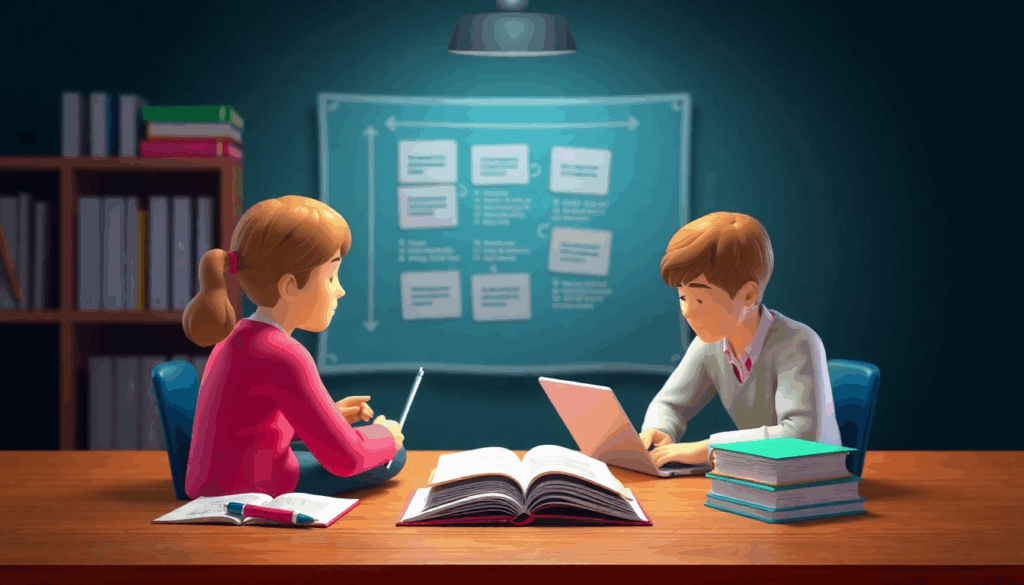As educators and school leaders, you know that lesson planning is the backbone of effective teaching. A high-quality lesson plan not only ensures that students meet learning objectives, aligned with state learning standards, but also keeps classroom learning engaging and joyful. However, the process can be time-consuming and complex—unless you leverage the right tools. In this blog, we’ll explore the essential steps for creating an effective lesson plan and show how AI tools for lesson planning, like Colleague AI, can transform your workflow, making it more efficient and tailored to your students’ needs.
Essential Steps for a High-Quality Lesson Plan
Creating an effective lesson plan requires thoughtful preparation and structure. Below are the key steps, backed by educational research, to ensure your lesson planning process is both impactful and streamlined.
1. Define Clear Learning Objectives
Every great lesson begins with a clear goal. What do you want your students to know or be able to do by the end? Objectives should be specific, measurable, and aligned with curriculum standards. They should also capture students’ learning progression. When learning objectives are communicated to students, they can understand what they will learn and what they will achieve during this lesson.
2. Assess Students’ Prior Knowledge
Understanding what your students already know is critical. This step helps you tailor content to their needs, avoiding redundancy or overwhelming them with material they’re unprepared for. Assessing prior knowledge can be accomplished through warm-up activities or quick reviews to scaffold new learning effectively.
3. Plan Engaging, Productive Learning Tasks
Tasks and activities are the heart of an effective lesson—they bring objectives to life. In addition to the expectation that tasks should align with objectives, activities should also provide engaging, productive learning opportunities for students. Here are several mechanisms and strategies to consider.
3.1. Engagement through Student Discourse and Group Work
- Active Questioning Techniques: Students articulate their thought processes and defend their ideas, promoting deeper understanding through verbal expression and peer interaction. This approach includes having students explain their reasoning, share solutions with partners, participate in class discussions, and support their positions with evidence.
- Collaborative Learning Structures: Collaborative learning creates opportunities for students to work together, learn from each other, and develop both academic and social skills. This framework incorporates peer tutoring, group problem-solving, partner verification activities, and structured cooperative learning experiences.
- Discussion Protocols: Discussion protocols provide structured frameworks for meaningful classroom conversations and peer interactions. These methods utilize question stems to guide deeper thinking, incorporate think-pair-share strategies, engage students in group summarization, and facilitate constructive peer feedback sessions.
3.2. Hands-on Activities and Multimedia
- Effective implementation of hands-on activities requires careful consideration of timing and sequence in the learning process. These hands-on activities should be purposefully designed to reinforce previously taught material, allowing students to apply their knowledge in concrete ways that connect to real-world situations. This sequential approach helps students build upon their existing understanding while making meaningful connections to practical applications.
- The integration of multimedia (audio, visual models) serves as a powerful complement to hands-on learning experiences. Visual representations, simulation videos, and audio engagement media (such as podcast) provide students with clear frameworks and engaging format for understanding complex concepts. Multimedia resources can offer multiple perspectives and representations of the same concept while supporting diverse learners.
3.3. Clear Instruction Practice and Workflow Structure
A well-structured lesson aligns with students’ learning progression based on learning science theories. For example, a lesson can begin with a 5-8 minute review of previous content, followed by the introduction of new material in digestible segments. As students demonstrate understanding, they transition to independent practice under close monitoring, with you – the teacher – providing immediate error correction and systematic feedback. This approach culminates in weekly and monthly reviews, creating a comprehensive learning cycle that reinforces student achievement through structured practice sequences and monitored independent work.
3.4. Effective scaffolding and differentiation strategies
These types of engagement strategies work in concert to create a comprehensive support system for student learning, beginning with cognitive supports such as think-aloud demonstrations, worked examples, step-by-step modeling and guidance, and visual prompts that make thinking processes visible and accessible to all learners. To enhance this scaffolded approach, you can implement various support tools, including self-evaluation checklists, task completion guides, error warning guides, reference materials, and choices, which empower students to develop independence and metacognitive awareness.
4. Incorporate Assessments
How will you know if your students have mastered the objectives? Assessments keep lessons focused and provide data to adjust instruction, including formative assessments (like quizzes or group work) during the lesson and summative assessments (like projects) at the end.
5. Gather Resources
Preparing all materials—handouts, tech tools, or visual aids—before class can take hours. You can use generative AI tools like Colleague AI to help streamline this process. Preparing materials in advance ensures smooth classroom delivery and minimizes disruptions.
6. Reflect and Adjust
After delivering the lesson, you should take a moment to evaluate what worked and what didn’t. Research shows that reflection helps teachers like you adapt to classroom dynamics and improve over time, making planning processes more effective.

Colleague AI: A Specialized AI Tool for Enhancing Lesson Planning Quality and Efficiency
Now that we’ve covered the essentials of lesson planning, let’s dive into how AI tools for teachers, specifically Colleague AI, can take your process to the next level. Here’s how this innovative platform aligns with the steps above while saving you time and boosting quality.
High-Quality and Personalized Content
“AI simplifies lesson planning, making it personalized and efficient by adapting to students’ unique needs.”
Colleague AI excels in generating high-quality, personalized content through its copyrighted models and framework, which are based on subject-specific best practices of teaching. With just a few clicks, you can generate lesson plans tailored to individual student performance and learning patterns, meeting clear objectives and aligning with state learning standards. Our models embed research knowledge on effective teaching practices and best practices of lesson planning into the latest AI models, ensuring that the generated content follows students’ learning progression, includes engaging activities, and offers multi-media content.
Streamlined Process with Intuitive Design
“Colleague AI automates tedious tasks, allowing teachers to focus more on teaching and less on administrative duties.”
Imagine creating a comprehensive lesson plan—complete with engaging slides, a podcast accompaniment, learning activities, assessments and worksheets—in minutes. Colleague AI’s user-friendly interface integrates all phases of instructional design into one workspace. Automated templates can be completed in moments with AI-generated content tailored to your lesson. This turns lesson planning from a time consuming chore, to a creative, fun process. Colleague AI generates rigorous and personalized learning for all students, including those with different learning styles and learning progression, students with disabilities, and English Language Learners.
AI as Your Knowledgeable Colleague, Working Alongside with You to Iteratively Refine
“As your trusted partner, Colleague AI enhances your professional expertise by collaborating with you to thoughtfully develop and refine your teaching materials, while always respecting your role as the educational decision-maker.”
Colleague AI features sophisticated nudging algorithms grounded in adult learning and motivation theories. As a trustworthy partner, Colleague AI provides thoughtful extensions, targeted follow-up questions, and professional-grade feedback to help you refine your learning materials. Additionally, Colleague AI maintains an extensive library of Open Educational Resources (OER), carefully curated with human expertise. You can evaluate these OER materials using our proprietary quality metrics and leverage our AI tools to adapt them to their specific teaching contexts and pedagogical styles.
Real-Time Collaboration
“User-friendly interfaces and real-time collaboration features enhance the teaching experience, enabling educators to collaborate and create engaging lesson plans easily.” Colleague AI’s collaborative workspace lets you work with your colleagues on generating lesson plans, sharing ideas and best practices in real time. This feature not only improves the quality of activities and assessments but also fosters a team approach to education—something traditional planning often lacks.

Caption: Educators collaborating seamlessly with a Specialized AI Tool in K-12 lesson Planning
Ethical and Continual Improvement
“At Colleague, we prioritize ethical AI practices and are committed to continually enhancing our platform.” Built with teacher input through interviews and co-design sessions, Colleague AI is designed to meet real classroom challenges. Its commitment to fairness and transparency ensures your lessons remain inclusive and effective, supporting the reflection and adjustment phases of planning.
Why Colleague AI Stands Out
Colleague AI isn’t just another teacher productivity tool—it’s a game-changer. By combining high-quality content, innovative AI, and a teacher-centric design, it addresses your pain points in lesson planning while enhancing student outcomes. Whether you’re an educator or a school leader overseeing curriculum, or a homeschooling parent, this AI tool for lesson planning empowers you to focus on what matters most: teaching and 1:1 interactions with your students.

Caption: Education technology transforming K-12 teaching and learning for the better.
Try Colleague AI For Free
Ready to revolutionize your lesson planning? Try Colleague AI for freetoday and experience how it simplifies the lesson-planing process while delivering personalized, high-quality lessons.
Or, watch the tutorial video to see it in action and discover why it’s the best AI tool for teachers. Don’t let administrative tasks hold you back—let AI lighten your load and elevate your teaching!
Citations and Resources
- Rosenshine, B. (2012). Principles of Instruction: Research-Based Strategies That All Teachers Should Know. American Educator. Available at: https://www.aft.org/sites/default/files/Rosenshine.pdf
- Institute of Education Sciences (2025). Elements of Effective Teaching. Available at: https://ies.ed.gov/ncee/wwc/PracticeGuide/1
- U.S. Department of Education (n.d.) TEAL Center Fact Sheet No. 8: Effective Lesson Planning. URL: https://lincs.ed.gov/state-resources/federal-initiatives/teal/guide/lessonplanning
- Milkova, S. (n.d.) Strategies for Effective Lesson Planning. Center for Research on Learning and Teaching (CRLT) at the University of Michigan. URL: https://crlt.umich.edu/gsis/p2_5


